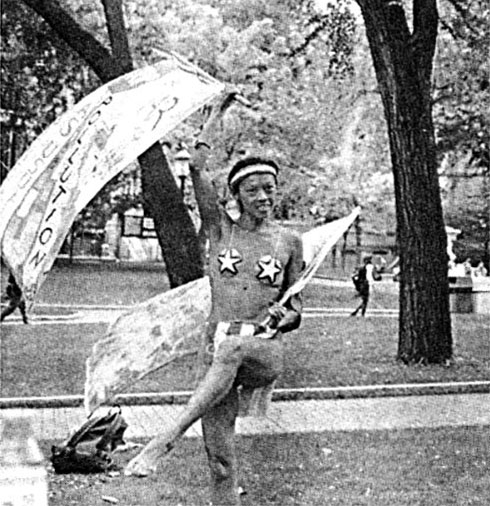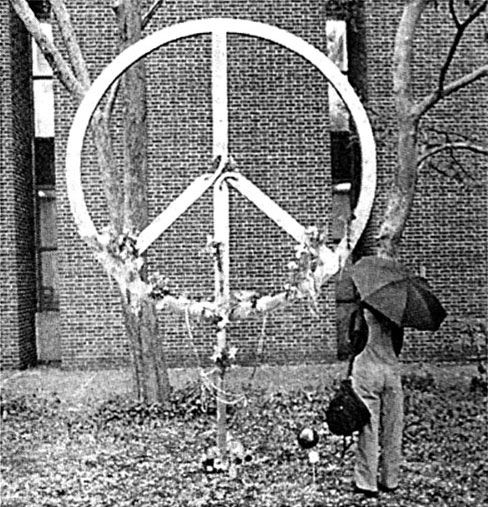Discography | Stage
Solid State | 2006
Solid State in performance—Peter Freeman and Jon Hassell.
Musicworks Fall 2006: Sonic Geography
by Doug Harvey
LOS ANGELES IS a chronically fragmented city, and that fact is reflected in most of its cultural landscape. It’s New Music scene is no exception, with a dozen or more autonomous scenes ranging from the heights of Disney Hall—host of the LA Philharmonic’s recent stellar Minimalism festival featuring John Adams, Terry Riley, Glenn Branca, and many others—to the depths of long-running downtown experimental noise venue The Smell. These particular extremes are, in fact, within blocks of one another, though there’s only a very slight overlap between their constituencies. The conceptual discontinuity is so strongly embedded that geographical concerns aren’t even considered—and as a result, surprising new phenomena crop up in the unlikeliest places.
Take, for example, The Natural History Museum of Los Angeles County. This venerable institution—founded in 1913 at the northern edge of South Central Los Angeles and home to some of the most highly-regarded wildlife dioramas in the museological world—hardly seems the kind of venue to find exciting experiments in New Music. Nevertheless, museum visitors were recently wowed by a double whammy of unique aural experiences—both prominently featuring avant-garde trumpeter/electronic composer Jon Hassell. Hassell is perhaps best known for his ongoing “Fourth World” hybridization of global tribal rhythms and forms with contemporary electronics processing, as exemplified by his collaborative work with Brian Eno on Fourth World Vol 1: Possible Musics (1980), though his activities run the gamut from 60’s electronic minimalism (he studied with Stockhausen and recorded with La Monte Young and Terry Riley) to 1999’s lyrical, jazz standards-heavy CD Fascinoma.
This audio twist at the NHM is a hybrid of its own, resulting from the combination of a series of invitational artists interventions into the museum collection and the public outreach series First Fridays, featuring late-evening lectures, performance, poetry, film screenings, and DJ sets that have become something of a favorite among students from nearby USC. These twin streams of programming recombined to produce “Sonic Scenery,” a set of exhibit-specific soundtracks on audiotour headsets created by artists ranging from multi-culti hip-hoppers Ozomatli and post-rock experimental guitar god Nels Cline to academic composeur Stephen Hartke and Marshall Allen’s Sun Ra Arkestra (who spent a whole night jamming in the Ancient Latin America Hall to generate their swaggering Nino-Rota-meets-Carla Bley-in-Tijuana improvisation.)
Of the two enormous main mammalian diorama halls that take up the bulk of the NHM’s main floor, the North American was tackled by literalist Bay-area sample pranksters (and Björk collaborators) Matmos, who fashioned a short but nuanced faux-soundscape for each of the 17 displays, to be viewed in sequence—resulting in a baroquely pleasurable sound-collage that—in situ—plays with the programmed choreography of conventional museum audiotourists. The African Hall was taken by Hassell, who produced a haunting text-sound composition out of a handful of looped fragments of Swahili conversation with just enough harmonics and shimmering reverb to make it to provide the numinous frisson suggested by its title “Wilderness Psalms”—and to subtly mimic the empty-auditorium acoustics of the enormous wood-paneled museum gallery.
A “First Friday” opening included a panel discussion, a history of ambient music in the form of a DJ set, and plug-in headphones-only “silent sets” by Matmos and others. But the real treat was at the last “First Friday” of the season, which centered around a rare live performance of Hassell’s “unrecordable” 1969 sound-sculpting installation Solid State mounted in the exquisitely opulent original marble rotunda, a mixture of Spanish Renaissance and art nouveau architectural motifs with the hushed lights and sonic ambience of a cathedral. Hassell and fellow knob-twister Peter Freeman placed their array of sound-generating equipment on the floor on the far side of the central giant figurative bronze light fixture (the muses of History, Science, and Art holding aloft the illuminating gas?), and as the 150 or so audience members sprawled on their backs or wandered the circular balcony, began sculpting.
Solid State is an entirely electronic work made from sounds generated by early Moog synthesiser in the basement of S.U.N.Y Buffalo in 1969—from the oscillators, two sets of pulse waves (a wave type characterized by dense overtone spectrum) tuned in perfect fifths C G D A E B F# C# were recorded to tape. In the new version, a CD with the original spectrum is gradually hand-modified through two very hi-quality, 1/3 band Klark Technik graphic EQ filters.
Four large speakers arrayed between pillars around the balcony of the domed rotunda transformed the two channels of sound into a complex matrix of overlapping patterns that shifted and evolved over the course of an hour according to Hassell and Freeman’s decisions, but also as one moved through the space. Only a few people moved around—including one lady inspired to perform an impromptu modern dance interpretation. A few others assumed yoga asanas but most of the audience sat or lay flat on the floor, engaged on a more contemplative level with the surprisingly trance-inducing electronic abstraction. Either way, the audience was privileged to take refuge in a bubble of simultaneously sacred and virtuosic experimental creativity for a full hour. Which is exactly the kind of unexpected epiphany that keeps LA’s music scene alive.
Hassell is busy with several projects—the exquisite Maarifa Street whose subtitle, Magic Realism 2, hints at connections to Aka-Darbari-Java / Magic Realism (1983)—was recently released to critical raves, and a full length Eno remix is rumored. His official website www.jonhassell.com offers updates on current projects as well as extensive historical materials. The fall series of the NHM’s “First Fridays” is still up in the air as I write, but Hassell is also included in a related NHM project at the Naturalis museum in the Netherlands with a piece that samples Dutch wildlife and Javanese gamelan. And be sure to visit their sub-site www.sonicscenery.com to purchase the soundtrack CD including Hassell’s “Wilderness Psalms.” To hear Solid State, you’ll just have to wait until it pops up in some other unlikely venue.
Doug Harvey is the Art Critic for LA Weekly,
a multidisciplinary artist, curator, professor, etc.

